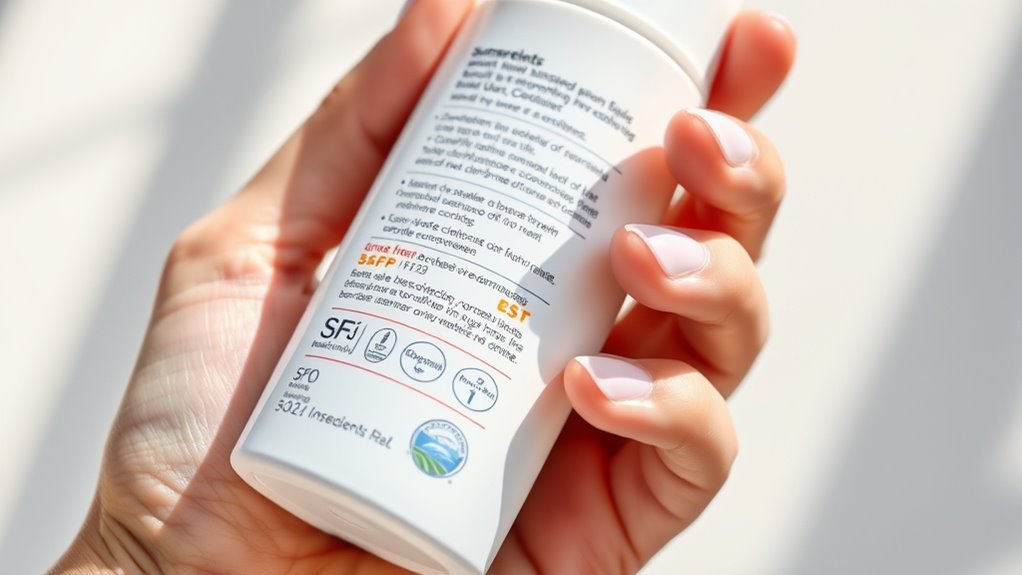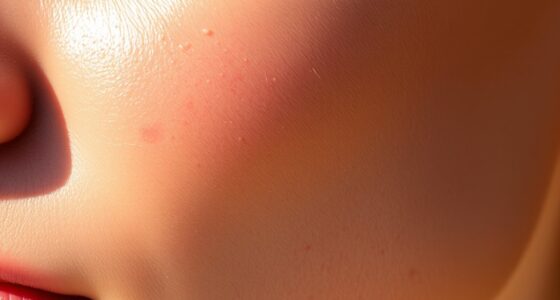To understand a sunscreen label, check the SPF number to see how long you’re protected against UVB rays—higher isn’t always better, but look for broad-spectrum protection that covers both UVA and UVB. Note the active ingredients for suitability and water resistance, which indicates how long they’re effective during water activities. Remember to reapply as directed. If you want to get the most out of your sun protection, continue exploring how label details guide your choices.
Key Takeaways
- Check the SPF number to understand the level of UVB protection, noting higher SPF offers slightly longer protection.
- Look for “Broad-spectrum” labels to ensure the sunscreen protects against both UVA and UVB rays.
- Review active ingredients like zinc oxide or avobenzene to assess UVA protection and skin compatibility.
- Note water-resistant labels and their duration (40 or 80 minutes) for water activities, and reapply accordingly.
- Follow reapplication instructions and remember that SPF alone doesn’t guarantee complete sun safety.

Understanding how to read a sunscreen label is essential for protecting your skin effectively. When you pick out sunscreen, one of the first things to check is the SPF, or Sun Protection Factor. SPF importance cannot be overstated because it indicates how long you can stay in the sun without burning compared to unprotected skin. For example, if your skin would typically burn after 10 minutes, an SPF 30 theoretically allows you to stay out for 300 minutes safely. However, keep in mind that SPF isn’t a perfect measure, and reapplication is key, especially if you’re sweating or swimming.
Check the SPF to understand how long your skin stays protected from sunburn.
Another critical aspect of reading the label is understanding UVA versus UVB rays. Many people focus solely on SPF, but both types of ultraviolet radiation can harm your skin. UVB rays are responsible for sunburns and are the primary cause of skin cancer, so protecting against them is essential. UVA rays penetrate deeper into your skin, contributing to premature aging and skin damage. Some sunscreens are labeled as broad-spectrum, which means they provide protection against both UVA and UVB rays. You should always opt for broad-spectrum formulas to ensure thorough protection.
The label will often specify the SPF level, such as SPF 15, 30, or 50, but it’s important to understand that higher SPF doesn’t mean you’re invincible. An SPF 50 blocks about 98% of UVB rays, whereas SPF 30 blocks around 97%, so the incremental benefit decreases as the SPF number rises. Also, remember that SPF mainly measures UVB protection; a high SPF doesn’t necessarily mean better UVA protection unless it’s broad-spectrum.
In addition to SPF and UVA/UVB info, check the ingredients list for active ingredients like zinc oxide or avobenzene, which provide physical or chemical UV protection. Some products also mention water resistance, which is important if you plan to swim or sweat. Water-resistant sunscreens maintain their SPF for a certain period, usually 40 or 80 minutes, but they need to be reapplied afterward. Understanding sunscreen ingredients can help you select the most suitable product for your skin type and activity level.
Frequently Asked Questions
What Does “Broad-Spectrum” Mean on a Sunscreen Label?
When a sunscreen label says “broad-spectrum,” it means the product offers UV protection against both UVA and UVB rays. This is important for skin safety because UVA rays can cause premature aging, while UVB rays lead to sunburn. Using a broad-spectrum sunscreen helps protect your skin from both types of rays, reducing the risk of skin damage and skin cancer. Always choose broad-spectrum for complete sun protection.
How Often Should I Reapply Sunscreen During the Day?
Think of your skin as a garden needing protection. Reapply sunscreen every two hours, especially during extended sun exposure. If you’re swimming or sweating, do it more often—every hour or sooner if needed. Remember, UV rays can penetrate clouds and windows, so reapplication is essential even on cloudy days. Keep your skin safe by maintaining a steady reapplication frequency, ensuring your skin’s resilience against sun damage throughout your day outdoors.
Are Higher SPF Sunscreens Always Better?
Higher SPF sunscreens aren’t always better, especially if you have sensitive skin or worry about SPF effectiveness. They do provide more UV protection, but they can also cause irritation or give a false sense of security, leading you to stay in the sun longer. For sensitive skin, choose a broad-spectrum sunscreen with an SPF that suits your activity and reapply regularly. Remember, no sunscreen blocks all UV rays completely.
Can I Use Sunscreen on My Face and Body Interchangeably?
You can’t really use sunscreen on your face and body interchangeably because skin absorption and facial sensitivity differ. The skin on your face is more delicate, so you need a gentle, non-comedogenic formula to avoid breakouts or irritation. It’s a case of “don’t put all your eggs in one basket,” so choose sunscreens tailored for each area. This way, you protect your skin without risking unwanted reactions.
Do Mineral and Chemical Sunscreens Work Differently?
Mineral and chemical sunscreens work differently to protect your skin. Mineral sunscreens, containing zinc oxide or titanium dioxide, create a physical barrier that reflects and scatters UV rays, offering broad-spectrum protection. Chemical sunscreens absorb UV radiation and convert it into heat, which is then dissipated. Your choice depends on your skin type and preferences; mineral options are often gentler, especially for sensitive skin, while chemical sunscreens tend to be lighter and less visible.
Conclusion
Now that you know how to read a sunscreen label, you’ll never be caught off guard at the store. Next time you pick up a bottle, it’s almost like the universe nudged you to find the perfect protection. With these tips, you’ll confidently choose the right SPF and ingredients, making sun safety second nature. It’s no coincidence—you’re now better equipped to keep your skin safe and healthy under the sun’s rays.









